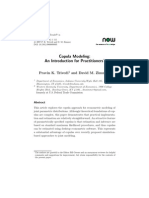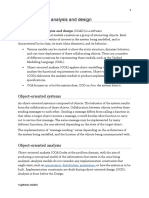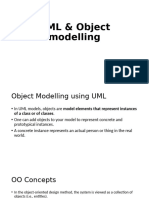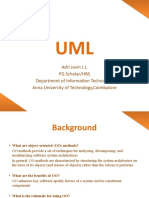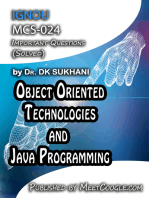Object Oriented Analysis and Design
Object Oriented Analysis and Design
Uploaded by
Arpita SahaCopyright:
Available Formats
Object Oriented Analysis and Design
Object Oriented Analysis and Design
Uploaded by
Arpita SahaCopyright
Available Formats
Share this document
Did you find this document useful?
Is this content inappropriate?
Copyright:
Available Formats
Object Oriented Analysis and Design
Object Oriented Analysis and Design
Uploaded by
Arpita SahaCopyright:
Available Formats
OODA 1
Object-oriented Analsis and design
Object-oriented analysis and design (OOAD) is a software engineering approach that
models a system as a group of interacting objects. Each object represents some entity of
interest in the system being modeled, and is characterised by its class, its state (data
elements), and its behavior. Various models can be created to show the static structure,
dynamic behavior, and run-time deployment of these collaborating objects. There are a
number of different notations for representing these models, such as the Unified
Modeling Language (UML).
Object-oriented analysis (OOA) applies object-modeling techniques to analyze
the functional requirements for a system. Object-oriented design (OOD) elaborates the
analysis models to produce implementation specifications. OOA focuses on what the
system does, OOD on how the system does it.
Object-oriented systems:
An object-oriented system is composed of objects. The behavior of the system results
from the collaboration of those objects. Collaboration between objects involves them
sending messages to each other. Sending a message differs from calling a function in that
when a target object receives a message, it itself decides what function to carry out to
service that message. The same message may be implemented by many different
functions, the one selected depending on the state of the target object.
The implementation of "message sending" varies depending on the architecture of the
system being modeled, and the location of the objects being communicated with.
Object-oriented analysis:
Object-oriented analysis (OOA) looks at the problem domain, with the aim of producing
a conceptual model of the information that exists in the area being analyzed. Analysis
models do not consider any implementation constraints that might exist, such as
concurrency, distribution, persistence, or how the system is to be built. Implementation
constraints are dealt during object-oriented design (OOD). Analysis is done before the
Design.
The sources for the analysis can be a written requirements statement, a formal
vision document, interviews with stakeholders or other interested parties. A system may
be divided into multiple domains, representing different business, technological, or other
areas of interest, each of which are analyzed separately.
The result of object-oriented analysis is a description of what the system is
functionally required to do, in the form of a conceptual model. That will typically be
presented as a set of use cases, one or more UML class diagrams, and a number of
interaction diagrams. It may also include some kind of user interface mock-up. The
purpose of object oriented analysis is to develop a model that describes computer
software as it works to satisfy a set of customer defined requirements.
Object-oriented design:
Object-oriented design is the process of planning a system of interacting objects for the
purpose of solving a software problem. It is one approach to software design.
Object-oriented design (OOD) transforms the conceptual model produced in
object-oriented analysis to take account of the constraints imposed by the chosen
architecture and any non-functional – technological or environmental – constraints, such
Software Engineering Suchismita Biswas
Sr. Lecturer, Dept. of IT
OODA 2
as transaction throughput, response time, run-time platform, development environment,
or programming language.
The concepts in the analysis model are mapped onto implementation classes and
interfaces. The result is a model of the solution domain, a detailed description of how the
system is to be built.
Input (sources) for object-oriented design:
The input for object-oriented design is provided by the output of object-oriented analysis.
Realize that an output artifact does not need to be completely developed to serve as input
of object-oriented design; analysis and design may occur in parallel, and in practice the
results of one activity can feed the other in a short feedback cycle through an iterative
process. Both analysis and design can be performed incrementally, and the artifacts can
be continuously grown instead of completely developed in one shot.
Some typical input artifacts for object-oriented design are:
• Conceptual model: Conceptual model is the result of object-oriented analysis, it
captures concepts in the problem domain. The conceptual model is explicitly chosen
to be independent of implementation details, such as concurrency or data storage.
• Use case: Use case is description of sequences of events that, taken together, lead to a
system doing something useful. Each use case provides one or more scenarios that
convey how the system should interact with the users called actors to achieve a
specific business goal or function. Use case actors may be end users or other systems.
In many circumstances use cases are further elaborated into use case diagrams. Use
case diagrams are used to identify the actor (users or other systems) and the processes
they perform.
• System Sequence Diagram: System Sequence diagram (SSD) is a picture that shows,
for a particular scenario of a use case, the events that external actors generate, their
order, and possible inter-system events.
• User interface documentations (if applicable): Document that shows and describes
the look and feel of the end product's user interface. It is not mandatory to have this,
but it helps to visualize the end-product and therefore helps the designer.
• Relational data model (if applicable): A data model is an abstract model that
describes how data is represented and used. If an object database is not used, the
relational data model should usually be created before the design, since the strategy
chosen for object-relational mapping is an output of the OO design process. However,
it is possible to develop the relational data model and the object-oriented design
artefacts in parallel, and the growth of an artefact can stimulate the refinement of
other artefacts.
Object-oriented concepts:
The five basic concepts of object-oriented design are the implementation level features
that are built into the programming language. These features are often referred to by these
common names:
• Object/Class: A tight coupling or association of data structures with the methods or
functions that act on the data. This is called a class, or object (an object is created
based on a class). Each object serves a separate function. It is defined by its properties,
what it is and what it can do. An object can be part of a class, which is a set of objects
that are similar.
Software Engineering Suchismita Biswas
Sr. Lecturer, Dept. of IT
OODA 3
• Information hiding: The ability to protect some components of the object from
external entities. This is realized by language keywords to enable a variable to be
declared as private or protected to the owning class.
• Inheritance: The ability for a class to extend or override functionality of another
class. The so-called subclass has a whole section that is derived (inherited) from the
superclass and then it has its own set of functions and data.
• Interface: The ability to defer the implementation of a method. The ability to define
the functions or methods signatures without implementing them.
• Polymorphism: The ability to replace an object with its subobjects. The ability of an
object-variable to contain, not only that object, but also all of its subobjects.
Characteristics of OOD:
• Objects are abstractions of real-world or system entities and manage themselves.
• Objects are independent and encapsulate state and representation information.
• System functionality is expressed in terms of object services.
• Shared data areas are eliminated. Objects communicate by message passing.
• Objects may be distributed and may execute sequentially or in parallel.
Advantages of OOD:
• Easier maintenance. Objects may be understood as stand-alone entities.
• Objects are potentially reusable components.
• For some systems, there may be an obvious mapping from real world entities to
system objects.
Output (deliverables) of object-oriented design:
• Sequence Diagrams: Extend the System Sequence Diagram to add specific
objects that handle the system events. A sequence diagram shows, as parallel
vertical lines, different processes or objects that live simultaneously, and, as
horizontal arrows, the messages exchanged between them, in the order in which
they occur.
• Class diagram: A class diagram is a type of static structure UML diagram that
describes the structure of a system by showing the system's classes, their
attributes, and the relationships between the classes. The messages and classes
identified through the development of the sequence diagrams can serve as input to
the automatic generation of the global class diagram of the system.
Software Engineering Suchismita Biswas
Sr. Lecturer, Dept. of IT
You might also like
- Object Oriented Analysis and Design NotesDocument62 pagesObject Oriented Analysis and Design Notesvraj patelNo ratings yet
- Copula Modeling: An Introduction For Practitioners: Pravin K. Trivedi and David M. ZimmerDocument111 pagesCopula Modeling: An Introduction For Practitioners: Pravin K. Trivedi and David M. ZimmervinizioNo ratings yet
- 1 (A) What Do You Understand by The Concept of Object Oriented Analysis and Design (OOAD) ?use Relevant ExamplesDocument3 pages1 (A) What Do You Understand by The Concept of Object Oriented Analysis and Design (OOAD) ?use Relevant Exampleswwwpts.1No ratings yet
- Object-Oriented Systems: Object-Oriented Analysis and Design (OOAD) Is ADocument3 pagesObject-Oriented Systems: Object-Oriented Analysis and Design (OOAD) Is AaamensankNo ratings yet
- YogiNotes OOADiDocument2 pagesYogiNotes OOADiyogendra sahuNo ratings yet
- Lab 1 Introduction To Object Oriented Software Engineering and Object Orientation in UmlDocument9 pagesLab 1 Introduction To Object Oriented Software Engineering and Object Orientation in Umlkpk kpkNo ratings yet
- Object Oriented Design: Shruti JatharDocument62 pagesObject Oriented Design: Shruti Jatharravi4185No ratings yet
- Object Oriented Analysis and DesignDocument60 pagesObject Oriented Analysis and DesignMatthew Tedunjaiye100% (1)
- Functional Decomposition Top-Down DevelopmentDocument19 pagesFunctional Decomposition Top-Down DevelopmentGeraldwerreNo ratings yet
- Ooad Technical TermsDocument12 pagesOoad Technical TermsdbmsisursNo ratings yet
- 01object Oriented System Design and AnalysisDocument46 pages01object Oriented System Design and Analysisvishals2003128No ratings yet
- What Is OOADDocument13 pagesWhat Is OOADKeerthi VasanNo ratings yet
- Unit IvDocument37 pagesUnit IvqifylyvyNo ratings yet
- Lab 01 Introduction To Object-Oriented Software Engineering and Object Orienta-Tion in UmlDocument10 pagesLab 01 Introduction To Object-Oriented Software Engineering and Object Orienta-Tion in Umlkhadija akhtarNo ratings yet
- Chapter 1Document27 pagesChapter 1YE' JEMBRU Lige EshetuNo ratings yet
- OOAD Model TypesDocument16 pagesOOAD Model TypesNitish RanaNo ratings yet
- Mcs 32Document11 pagesMcs 32karenpinto100% (1)
- Object Oriented System Analysis and DesigDocument5 pagesObject Oriented System Analysis and DesigAbnetastroNo ratings yet
- Object-Oriented Analysis and Design (OOAD) Is A SoftwareDocument4 pagesObject-Oriented Analysis and Design (OOAD) Is A SoftwarenagulanathanNo ratings yet
- Object Oriented Analysis and DesignDocument33 pagesObject Oriented Analysis and DesignShwetank SharmaNo ratings yet
- Object-Oriented Analysis and Design (OOAD)Document6 pagesObject-Oriented Analysis and Design (OOAD)akyadav123No ratings yet
- Soft Engg 4Document12 pagesSoft Engg 4tapstaps902No ratings yet
- Cs2353 Object Oriented Analysis and DesignDocument4 pagesCs2353 Object Oriented Analysis and DesignJanani AecNo ratings yet
- Object Oriented Design (OOD) : Presenting By: M R Khan Dipu ID: 191-35-393 Department of Software EngineeringDocument14 pagesObject Oriented Design (OOD) : Presenting By: M R Khan Dipu ID: 191-35-393 Department of Software EngineeringM. R. KHAN DIPUNo ratings yet
- OOMD Notes Part ADocument74 pagesOOMD Notes Part ANitin Talhar50% (2)
- Chapter 1 IntroductionDocument16 pagesChapter 1 Introductionkshitijsriram2683No ratings yet
- OOMD Module 1Document23 pagesOOMD Module 1anilkali2004No ratings yet
- SEPM Module 2Document37 pagesSEPM Module 2deepika seranNo ratings yet
- Principles of Object Technology: First Principle of ModelingDocument4 pagesPrinciples of Object Technology: First Principle of ModelingSweetsoulUroojMalikNo ratings yet
- Object Oriented ApproachDocument28 pagesObject Oriented ApproachGlobal AccessNo ratings yet
- Phases in Object-Oriented Software DevelopmentDocument20 pagesPhases in Object-Oriented Software DevelopmentAlvo KamauNo ratings yet
- Oomd BasicsDocument18 pagesOomd BasicsVignesh KarthiNo ratings yet
- Oomethodologies-Lecture 5Document20 pagesOomethodologies-Lecture 5Dex TreNo ratings yet
- An Oop Nots - 020022Document18 pagesAn Oop Nots - 020022Abdul-halim HafidhNo ratings yet
- OOSD Notes KietDocument46 pagesOOSD Notes Kietshiv.2125csit1121No ratings yet
- Adri Jovin J.J. PG Scholar/HBS Department of Information Technology Anna University of Technology, CoimbatoreDocument29 pagesAdri Jovin J.J. PG Scholar/HBS Department of Information Technology Anna University of Technology, CoimbatoreAdri JovinNo ratings yet
- Dit 0202 Week TwoDocument18 pagesDit 0202 Week TwoAli DoyoNo ratings yet
- Building The Analysis Mode1 - 1Document6 pagesBuilding The Analysis Mode1 - 1alukapellyvijayaNo ratings yet
- Design PatternsDocument89 pagesDesign PatternsS M ANo ratings yet
- Object Modeling and C++ Programming For Bca 2nd Semester PDFDocument44 pagesObject Modeling and C++ Programming For Bca 2nd Semester PDFsatyapt007No ratings yet
- Unit 3 Software EngineeringDocument17 pagesUnit 3 Software Engineeringyashthakare9267No ratings yet
- The Object Oriented ApproachDocument12 pagesThe Object Oriented ApproachScribdTranslationsNo ratings yet
- Object Oriented Design EducativeDocument429 pagesObject Oriented Design Educativerp singhNo ratings yet
- OOMD Unit 1Document13 pagesOOMD Unit 1Saraswati BhusanurNo ratings yet
- Why Is Object Oriented System Important? State 2 Orthogonal Views of The Software ?Document6 pagesWhy Is Object Oriented System Important? State 2 Orthogonal Views of The Software ?Ravi Mohan BhattNo ratings yet
- Determining How To Build Your System: Object-Oriented DesignDocument7 pagesDetermining How To Build Your System: Object-Oriented DesignShumet WoldieNo ratings yet
- Oosad CH2Document8 pagesOosad CH2Malicha GalmaNo ratings yet
- III OoadDocument21 pagesIII Ooadsairam kamalayNo ratings yet
- Unit 7 Design-and-ImplementationDocument31 pagesUnit 7 Design-and-ImplementationMysto GanNo ratings yet
- Unit-3 Notes OosdDocument20 pagesUnit-3 Notes Oosdyou • were • trolled0% (1)
- SE - Unit - 3Document23 pagesSE - Unit - 3Vandana . RNo ratings yet
- CS2353 Object Oriented Analysis and DesignDocument71 pagesCS2353 Object Oriented Analysis and Designmani4876No ratings yet
- OOSE IMP NotesDocument3 pagesOOSE IMP Notesyuvrajkhirid123No ratings yet
- Unit-V - OOP Concept Design & UMLDocument80 pagesUnit-V - OOP Concept Design & UMLroyalsharma1941No ratings yet
- Uml ModelsDocument25 pagesUml ModelsNorife Z GonzalesNo ratings yet
- Spiral Model of The Software ProcessDocument17 pagesSpiral Model of The Software ProcessAmol MNo ratings yet
- AOP in Spring: An Introduction To Aspect-Oriented Programming With The Spring FrameworkDocument24 pagesAOP in Spring: An Introduction To Aspect-Oriented Programming With The Spring FrameworkmanojNo ratings yet
- CS-701 NFA and TG Module-5 (1) - 1Document59 pagesCS-701 NFA and TG Module-5 (1) - 1gnisar327No ratings yet
- Ma8451 PRP Model Set BDocument3 pagesMa8451 PRP Model Set BInfi Coaching CenterNo ratings yet
- Generalized Method of Moments Estimation PDFDocument29 pagesGeneralized Method of Moments Estimation PDFraghidkNo ratings yet
- SLIDE 7 Object and State Chart DiagramDocument21 pagesSLIDE 7 Object and State Chart DiagramRidge RagiraNo ratings yet
- Automataetl They Are Very HelpfulDocument54 pagesAutomataetl They Are Very HelpfulMichael MangahasNo ratings yet
- Deep Learning Techniques For Cyber Security Intrusion Detection: A Detailed AnalysisDocument11 pagesDeep Learning Techniques For Cyber Security Intrusion Detection: A Detailed AnalysisSalmaanCadeXaajiNo ratings yet
- Type Materials Reviewed: Review For Exam Chapter - 3 - Special - Distributions PDFDocument14 pagesType Materials Reviewed: Review For Exam Chapter - 3 - Special - Distributions PDFhoa.tranquangducNo ratings yet
- Updated MCQ On TAFLas Per AKTU Syllabus (Unit 5) )Document59 pagesUpdated MCQ On TAFLas Per AKTU Syllabus (Unit 5) )Rudra SaraswatNo ratings yet
- OOSD Notes KietDocument46 pagesOOSD Notes Kietshiv.2125csit1121No ratings yet
- Lecture Notes - Optimal Control (LQG, MPC)Document76 pagesLecture Notes - Optimal Control (LQG, MPC)mindthomasNo ratings yet
- Unit II Supervised IIDocument16 pagesUnit II Supervised IIindiraNo ratings yet
- Simulasi Vending Machine Dengan Mengimplementasikan Finite State AutomataDocument7 pagesSimulasi Vending Machine Dengan Mengimplementasikan Finite State AutomataSinggih PramanaNo ratings yet
- Laporan Tugas Besar Si 3211 - Analisis Struktur SEMESTER II TAHUN 2018/2019Document16 pagesLaporan Tugas Besar Si 3211 - Analisis Struktur SEMESTER II TAHUN 2018/2019anon_124002009No ratings yet
- MCQ Binomial and Hypergeometric Probability Distribution With Correct AnswersDocument5 pagesMCQ Binomial and Hypergeometric Probability Distribution With Correct Answersranit9880% (5)
- Econometrics MadalaDocument1 pageEconometrics MadalaHimadri PalikheNo ratings yet
- Sequence Generation With RNNs - Pre Quiz - Attempt ReviewDocument5 pagesSequence Generation With RNNs - Pre Quiz - Attempt ReviewAman Mourya100% (1)
- Formal Languages and Automata: Lab 4. ExercisesDocument2 pagesFormal Languages and Automata: Lab 4. ExercisesYuri KimNo ratings yet
- Bio23 LindenDocument34 pagesBio23 LindenDjamal ToeNo ratings yet
- Chapter 5, Analysis: Dynamic ModelingDocument37 pagesChapter 5, Analysis: Dynamic ModelingShivani KapaniaNo ratings yet
- Poisson Distribution: The Poisson Distribution Is Used When A RandomDocument5 pagesPoisson Distribution: The Poisson Distribution Is Used When A RandomDipta Kumar Nath 1612720642No ratings yet
- Finite Automata: Anab Batool KazmiDocument54 pagesFinite Automata: Anab Batool KazmiAfia FaheemNo ratings yet
- The International University of Scholars: Department of Computer Science & EngineeringDocument2 pagesThe International University of Scholars: Department of Computer Science & EngineeringGK KaderyeNo ratings yet
- Review ERD Dan EERDocument21 pagesReview ERD Dan EERaliffahrahmi100% (3)
- Lecture 9. ARIMA ModelsDocument16 pagesLecture 9. ARIMA ModelsPrarthana PNo ratings yet
- Probability and Random Processes: Lessons 10-13 Joint DistributionsDocument108 pagesProbability and Random Processes: Lessons 10-13 Joint DistributionsvrsafeNo ratings yet
- SR No Name Author 1 2 3: G. Reference BooksDocument4 pagesSR No Name Author 1 2 3: G. Reference BooksmahendrabpatelNo ratings yet
- Se Lec 10Document34 pagesSe Lec 10Naima Naeem 631-FBAS/BSIT/F21No ratings yet
- Time Series Analysis Exercises: Universität PotsdamDocument30 pagesTime Series Analysis Exercises: Universität PotsdamSD100% (1)

